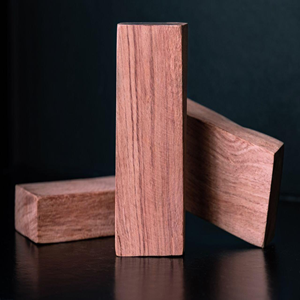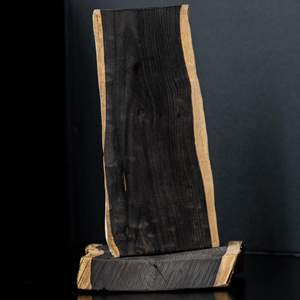AFRICAN ROSEWOOD
Popular Names: Bubinga, kevazingo, African rosewood
Scientific name: Guibourtia spp., the three principal species are G. demeusei, G. pellegriniana, and G. tessmannii
Distribution: Equatorial Africa
Tree Size: 40-45 m tall,
1-2 m trunk diameter
Average Dried Weight: 890 kg/m3
Specific Gravity (Basic, 12% MC): 0.72, 0.89
Janka Hardness: 10,720 N
Modulus of Rupture: 168.3 MPa
Elastic Modulus: 18.41 GPa
Crushing Strength: 75.8 MPa
Shrinkage: Radial: 6.0%, Tangential: 8.2%,
Volumetric: 13.9%, T/R Ratio: 1.4
Color/Appearance: Heartwood ranges from a pinkish red to a darker reddish brown with darker purple or black streaks. Sapwood is a pale straw color and is clearly demarcated from the heartwood. Bubinga is very frequently seen with a variety of figure, including pommele, flamed, waterfall, quilted, mottled, etc.
Grain/Texture: Grain is straight to interlocked. Has a uniform fine to medium texture and moderate natural luster.
Rot Resistance: Ranges from moderately durable to very durable depending upon the the species. Bubinga is also reported to be resistant to termite and marine borer attack.
Workability: Easy to work overall, though depending upon the species bubinga can have silica present, which can prematurely dull cutting edges. Also, on pieces with figured or interlocking grain, tearout can occur during planing or other machining operations. Gluing can occasionally be problematic due to bubinga’s high density and natural oils. Turns and finishes well.
Odor: Bubinga is reported to have an unpleasant scent when the lumber is still wet, which disappears after the wood is dry.
Allergies/Toxicity: Although severe reactions are quite uncommon, bubinga has been reported to cause skin irritation and/or skin lesions in some individuals. See the articles Wood Allergies and Toxicity and Wood Dust Safety for more information.
Pricing/Availability: Despite being an endangered species, bubinga continues to have decent availability in North America. Prices for unfigured wood are in the mid range for an imported hardwood. Figured grain patterns such as waterfall, pommele, etc. are much more expensive.
Sustainability: The three Guibourtia species yielding bubinga are listed on CITES appendix II—which also includes finished products made of the wood (though non-commercial finished items under 10 kilograms are exempted). Additionally, of the three bubinga species, two of them (G. pellegriniana and G. tessmannii) are on the IUCN Red List as endangered, while the third, G. demeusei, is listed as near threatened.
Common Uses: Veneer, inlays, fine furniture, cabinetry, turnings, and other specialty items. Since bubinga trees can grow so large, natural-edge slabs of the wood have also been used in tabletops and other specialized projects.
Comments: An immensely popular imported African hardwood, bubinga may be loved as much for its quirky name as it is for its strength and beauty. The wood is sometimes called kevazingo, a name usually applied to its decorative rotary-cut veneer. In addition to its myriad grain patterns, its strength-to-weight ratio (specifically its MOR) also ranks among the very best in the world.
Bubinga has a close resemblance to rosewood, and is sometimes called African rosewood—though this name is more commonly applied to another Guibourtia species, Guibourtia coleosperma. However, its similarity to true rosewoods has been a double-edged sword, as the wood has been heavily exploited in recent years in the Chinese hongmu (rosewood) market—resulting in a ban not only on true rosewoods, but also bubinga as well.
Sawing size you can request by e-mail: This email address is being protected from spambots. You need JavaScript enabled to view it.





